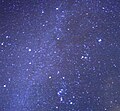Orionids
Appearance

The Orionids are an annual meteor shower that occurs at and are named after their radiant, which is located near the constellation Orion. The peak of the Orionid meteor shower occurs around October 21 and produces from ten to fifteen meteors per hour.
The Orionid meteor shower is produced by the well-known Halley’s Comet, which was named after the astronomer Edmund Halley and last passed through the inner solar system in 1986 on its 75-to-76-year orbit.
The radiant of the Orionids is located between the Orion and Gemini constellations (in the south-eastern sky before dawn, as viewed from mid-northern latitudes).[1]
Gallery
-
Orionid
-
Two Orionids and Milky Way
-
Multi-colored Orionid
-
The brightest meteor, a fireball, leaves a smokey persistent trail drifting in high-altitude winds, which is seen at the right-hand side of the image.
References
See also





